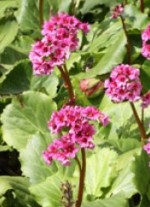 Bergenia is genus of semi-evergreen herbaceous perennials and belong to the saxifrage family, Saxifragaceae, that also includes Astilbe, Heuchera, Tiarella, and Rodgersia. It is native to central Asia but is a popular garden plant because of its attractive foliage and flowers. Plants have a rhizomatous root stock and form clumps of bold, paddle or oar shaped leathery leaves that turn red or bronze in the fall where the climate is cool. Waxy pink cone-shaped flowers 1.4″ to 1/2″ across appear in spring in dense upright clusters 5-6″ tall. The common name pigsqueak comes from the sound made when two leaves are rubbed together. The genus name, Bergenia, honors Karl August von Bergen, 18th century professor at Frankfurt an der Oder.Bergenias like moist, humus-rich, well-drained soil in full sun to light shade and tolerate alkaline soils and drought. In the North they can be planted in full sun but in the South the leaves need protection in the afternoon. Leaves can become damaged by both slugs and cold. The flower buds are more sensitive to cold than the leaves but even when damaged the plants are an asset in the garden because of the foliage. Propagation is by seed or division in spring and division every 3-5 years keeps plants vigorous. Bergenias are effective in borders, along pathways, and as a ground cover. The leaves are especially useful in bouquets as they last a long time after cutting. White flowered cultivars are available.
Bergenia is genus of semi-evergreen herbaceous perennials and belong to the saxifrage family, Saxifragaceae, that also includes Astilbe, Heuchera, Tiarella, and Rodgersia. It is native to central Asia but is a popular garden plant because of its attractive foliage and flowers. Plants have a rhizomatous root stock and form clumps of bold, paddle or oar shaped leathery leaves that turn red or bronze in the fall where the climate is cool. Waxy pink cone-shaped flowers 1.4″ to 1/2″ across appear in spring in dense upright clusters 5-6″ tall. The common name pigsqueak comes from the sound made when two leaves are rubbed together. The genus name, Bergenia, honors Karl August von Bergen, 18th century professor at Frankfurt an der Oder.Bergenias like moist, humus-rich, well-drained soil in full sun to light shade and tolerate alkaline soils and drought. In the North they can be planted in full sun but in the South the leaves need protection in the afternoon. Leaves can become damaged by both slugs and cold. The flower buds are more sensitive to cold than the leaves but even when damaged the plants are an asset in the garden because of the foliage. Propagation is by seed or division in spring and division every 3-5 years keeps plants vigorous. Bergenias are effective in borders, along pathways, and as a ground cover. The leaves are especially useful in bouquets as they last a long time after cutting. White flowered cultivars are available.
The following Bergenias are recommended for gardens:
Winter Begonia (B. ciliata)
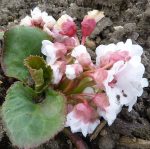
Leaves are densely hairy, almost circular and 9-12″ wide; leaves die back in the winter unlike other Bergenias.
Height: 12″-24″
Flower Color: Pale pink
Hardiness: Zones 6-10 (but does not tolerate high humidity)
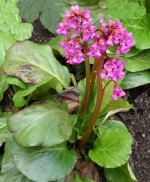 Heart-Leaf Bergenia (B. cordifolia)
Heart-Leaf Bergenia (B. cordifolia)
Cabbage-like leaves turn bronze in the winter. ‘Perfect’ has rosy red flowers and is taller than the species.
Height: 12-18″
Flower Color: Pink
Hardiness: Zones 3-8
Winter-Blooming Bergenia (B. crassifolia)
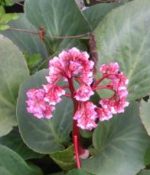 Similar to B. cordifolia but leaves are spoon-shaped rather than heart-shaped, flowers are held higher over foliage, and the flowering stem is branched. Leaves turn deep pink in winter.
Similar to B. cordifolia but leaves are spoon-shaped rather than heart-shaped, flowers are held higher over foliage, and the flowering stem is branched. Leaves turn deep pink in winter.
Height: 12-18″
Flower Color: Magenta
Hardiness: Zones 4-8
B. purpurascens
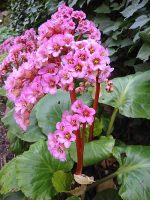 Noted for the crimson color of the leaves in winter.
Noted for the crimson color of the leaves in winter.
Height: 12-18″
Flower Color: Deep pink on purple red stems
Hardiness: Zones 4-9